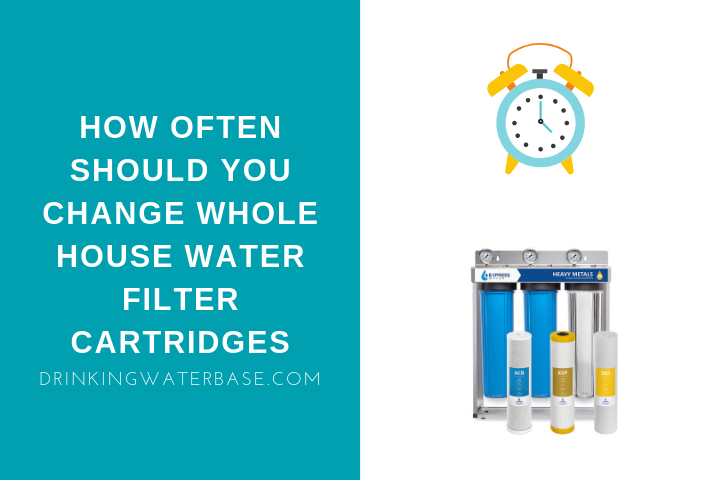If you have read some of my previous articles, you probably know that I usually advise changing filters no longer than every six months. In today’s article, I will tell you how often should you change whole house filter cartridges, and what are the things that affect the lifespan of the filter.
There is no definite answer as to when you should replace the cartridge. This is determined mostly by two factors: the number of contaminants in water and the size of your household. The more contaminants and number of people means more frequent replacement. Although the usual lifespan of whole house filters is claimed to be between 3-12 months.
Without any delay, let’s get a deeper look.
The Extent of Water Contamination
Probably the most important criterion that affects the lifespan of any filter, not just the whole house, is the level of water contamination.
I mean, many contributors cause water pollution like natural pollutants such as sediment or heavy metals, but also agricultural and industrial pollution. The first step to understand how often you should change cartridges would be to analyze your water.
Sometimes, when water is heavily contaminated, you can tell straight away. It might have an unpleasant odor, awful taste, or ugly unnatural color. Often it is the combination of all.
There are a few basic steps you can make to evaluate the water quality. The easiest and the most reliable thing to do is to collect a sample of water and send it to the lab, or even testing at home will give you a good idea on your water quality.
Additionally, you can simply look at the region where you live and see what industry is nearby maybe agriculture, or metallurgy? This will give you an idea of what contaminants you can expect to be found in water.
Or you could also reach out to your local authority and ask them to provide you with the report. These should be available to issue for the public.
Is City Water Cleaner Compared to Well Water?
One thing I don’t want you to be confused about is that if you are connected to city supplied water, you are safe from contaminants. Yes, water is passing through the treatment plant, although the filtration is not perfect either.
The difference is that well, or in other words, groundwater is not treated before entering your house. The research has shown that over 80% of wastewater is going back to the environment without any treatment. Just think about it for a second, how big is the chance that something will get into the unprotected groundwater.
The bottom line is:
Understanding what is in your tap water will give you a good idea on what you should expect from the filter in terms of lasting life. It is not just a seller scamming you by selling you cartridge of poor quality. But it might as well be that your water is just horrible. So, just be aware of this option too.
So, let’s get to another significant contributor to cartridge lifespan.
Household Water Usage
The overall water usage in your house will also determine how often you will have to replace the cartridge.
Now, according to USGS average daily water consumption is roughly 80-100 gallons per day. I would like to do some further calculations to give you the idea of how long will your filter last.
For the purpose of calculations, let’s take the baseline of 100 gallons per person per day. Also, I will calculate the household of four people.
By multiplying 100×4, we get usage of 400 gallons a day. Although, we need to know our consumption per year, so just multiply 400 by 365, and you get a number 146,000 gallons.
This was only the rough estimation based on averages, but if I am honest, the game of averages is very short-sighted. I mean, you ate two apples, and I didn’t eat any. Yet on average, we both ate an apple.
So, how can you estimate your usage?
The answer is water meter.
This is a great way to estimate your individual household usage. Write your water meter readings down and set a reminder to check in a week or month. Basically, the more time you will give yourself a better estimate you can make.
Generally, in the US, water meters measure either in gallons or cubic feet. One cubic foot is 7.48 gallons.
Basically, just write down your meter readings and recheck them later. The difference between the two numbers is how much you have used in the time between. Let’s say you have given yourself one month, and reading says you have used 50 cubic feet. This means that you have used 374 gallons in one month.
Just multiply this number by 12 months, and here is your estimated usage per year.
Alternatively, you can just look at the previous water bills.
I hope we are clear on this parameter, but shoot any questions you have in the comments below. In the meantime let’s talk about the lifespan of cartridges.
Whole House Filter Lifespan
There is a huge variety of whole house units ranging from single stage to five stages unit. The size of the filter also greatly affects lifespan.
When you then search for the filter, you can see a vast gap of estimated lifespan ranging from 30,000 going all the way up to 1,000,000 gallons.
Note, that filters that can last one million gallons are not using standard cartridges. So let’s get back to the cartridge-based filters.
The gap closes quite a bit, and manufacturers of these don’t usually report lifespan more than 150,000 gallons.
I must repeat myself, but use these numbers as a rough estimation, because it hugely depends on the water quality.
Keep reading as in the next chapter we will discuss at what point cartridge is no longer efficient and it’s time to replace it.
How to Tell When Water Filter Needs Replacement
It is not that difficult to tell when you have to replace the cartridge, when your water is heavily contaminated.
You will probably notice some or all of the following symptoms that show it’s time.
- Water flow drop – cartridge is clogged
- Change of taste
- Water changes its color
- Unpleasant smell
- Visible sediment in water
If you notice the issues mentioned above, then it is a clear sign that you need a new cartridge.
Sometimes though, it is not that obvious, especially when contaminants in water are soluble. These are really hard to detect because usually, they don’t have any visible characteristics.
Some of the contaminants that fall into this category are fluoride, pesticides, bacteria, BPA, dissolved salts and much more. Certain metals could also be difficult to detect, especially if the levels are low. However, the long term exposure to these could lead to health issues developed over time.
So how can you tell when replacement is needed if you can’t see the difference in water quality?
Really, you have two options that would work well, especially if you combine them.
First of all, I would use a sticker with a date on the cartridge, when you have installed it. By doing this, you will be able to see how much time you have been using a filter.
Next step would be to set up a reminder on your phone. I would say in three months.
Now, once the three months have passed, you can test the water using basic test strips to check the performance of the filter. If levels are still low, set up a reminder for the next three months and do the same.
In case you are not sure about what testing kit you should use, you can use this kit on Amazon. I like this one because it offers a variety of contaminants you can check.
Now you can confidently tell when the cartridge needs to be replaced, but what happens if you don’t?
Let’s find out right now.
What Happens If You Don’t Change Your Filter
Let’s say you forget to replace the cartridge. Be honest, we all live busy lives, so this is an authentic scenario.
To estimate the total impact, you need to know how much time has passed since the time you should have replaced the filter. Now, if its a week, then likely the impact won’t be more significant than the fact that cartridge stop filtering water and that’s it.
If the old cartridge is not replaced for a long time, months or more, the mixture of contaminants and moist environment is the perfect breeding ground for bacteria.
From that point, your water is not free from contaminants. It potentially could become contaminated with bacteria breed in the filter.
The bottom line is that to keep benefiting from the filtration, the regular replacement of the cartridge is necessary.
TIP: Every time you replace the cartridge, make sure you wash the housing properly, as bacteria might breed there already. By doing this, you will maintain the safety of water and keep the performance of the filter.
Final Words
As you can see, replacing cartridges is an absolutely necessary part of the maintenance. Although regions have different levels of contamination, it is not that difficult to check it for your area. This knowledge will give you a hint about how long could the filter last before it needs to be replaced.
Now, it’s your turn to share your knowledge or opinions.
- How often do you replace cartridges in your filter?
- How else you can determine that it’s time to replace it? Share some of the methods your are following.
Leave your answers in the comment section below.


